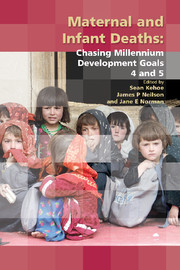Book contents
- Frontmatter
- Contents
- Participants
- Declaration of personal interests
- Preface
- The Millennium Development Goals
- SECTION 1 THE SIZE OF THE PROBLEM
- SECTION 2 CLINICAL PROBLEMS AND SOLUTIONS – MATERNAL
- SECTION 3 CLINICAL PROBLEMS AND SOLUTIONS – NEONATAL
- SECTION 4 TRAINING AND DEVELOPMENT
- 14 Capacity development – a midwifery perspective
- 15 Increasing the capacity for essential obstetric and newborn care
- 16 The role of the Royal Colleges in training and development
- SECTION 5 SPECIFIC CHALLENGES IN SPECIFIC COUNTRIES
- SECTION 6 CONSENSUS VIEWS
- Index
14 - Capacity development – a midwifery perspective
from SECTION 4 - TRAINING AND DEVELOPMENT
Published online by Cambridge University Press: 05 February 2014
- Frontmatter
- Contents
- Participants
- Declaration of personal interests
- Preface
- The Millennium Development Goals
- SECTION 1 THE SIZE OF THE PROBLEM
- SECTION 2 CLINICAL PROBLEMS AND SOLUTIONS – MATERNAL
- SECTION 3 CLINICAL PROBLEMS AND SOLUTIONS – NEONATAL
- SECTION 4 TRAINING AND DEVELOPMENT
- 14 Capacity development – a midwifery perspective
- 15 Increasing the capacity for essential obstetric and newborn care
- 16 The role of the Royal Colleges in training and development
- SECTION 5 SPECIFIC CHALLENGES IN SPECIFIC COUNTRIES
- SECTION 6 CONSENSUS VIEWS
- Index
Summary
Introduction: capacity development challenges and complexities
The lack of midwives to provide access to the worlds' 10 million women and their newborn by 2015 is well recognised and documented, with only 59% of births in the developing world attended by skilled healthcare workers — trained midwives, doctors or nurses. This access deficiency aligns with countries that experience the greatest shortages. The Economic and Social Council noted in its Annual Ministerial Review that across the globe the distribution of healthcare workers is inequitable, with vast gaps between developed and developing countries, as well as within countries between urban and rural areas. Capacity development and human resource shortages are interrelated: one cannot be considered independently of the other and both need to be considered as part of a system whole. While the challenge of capacity development is an issue across the globe, it is greater in developing countries and greatest in fragile states. It is known that fragile states have less than one health worker for every 1000 people and one in four pregnant women gives birth alone or with a family member. The lifetime risk of maternal death is one in 8000 in the Global North compared with one in 76 in the Global South. It is estimated that 75% of mothers' lives could be saved if women had access to a skilled health worker at birth and to emergency obstetric care. The case for urgent capacity development is clear.
- Type
- Chapter
- Information
- Maternal and Infant DeathsChasing Millennium Development Goals 4 and 5, pp. 219 - 228Publisher: Cambridge University PressPrint publication year: 2010
- 3
- Cited by



